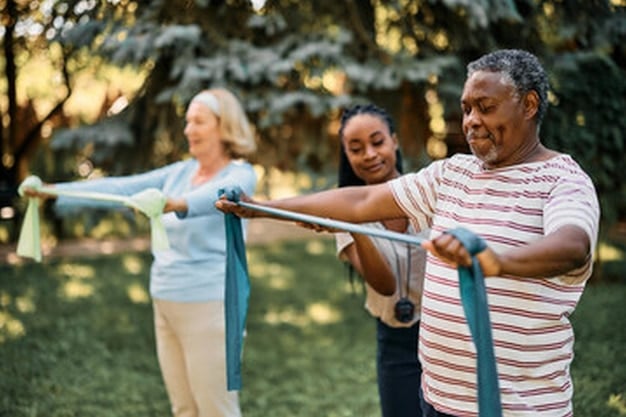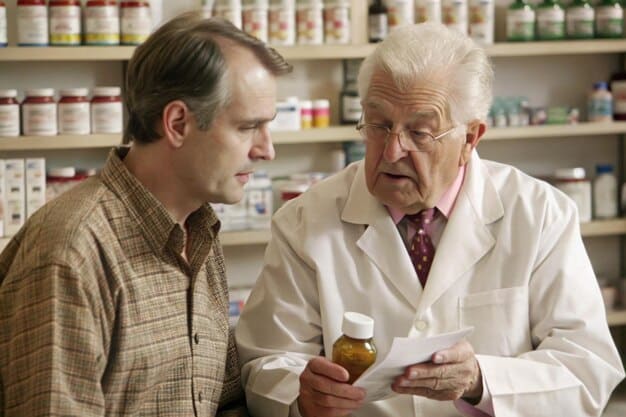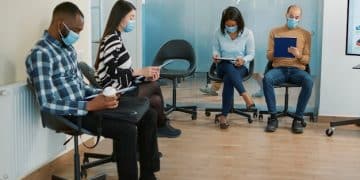The Role of Public Health in Promoting Healthy Aging

Public health plays a crucial role in promoting healthy aging by implementing strategies focused on disease prevention, health promotion, and creating supportive environments for older adults, thus enhancing their overall quality of life.
The global population is aging, presenting both opportunities and challenges for public health systems. Addressing the health and well-being of older adults requires a comprehensive approach, emphasizing prevention, health promotion, and supportive environments. Understanding the role of public health in promoting healthy aging: strategies for an aging population is crucial for creating a society where individuals can thrive throughout their lives.
Understanding the Aging Population
The world is experiencing a demographic shift with a growing number of older adults. This necessitates a deeper understanding of the unique health challenges and opportunities that come with aging. Recognizing these factors is crucial for developing effective public health strategies.
Demographic Trends
Globally, life expectancy has increased, leading to a larger proportion of older adults in the population. This trend poses new challenges for healthcare systems and public health infrastructure. Understanding these demographic shifts is essential for planning and resource allocation.
Health Challenges of Aging
Older adults are more susceptible to chronic diseases such as heart disease, diabetes, and arthritis. Additionally, cognitive decline and mental health issues like depression can significantly impact their quality of life. Addressing these health challenges requires targeted public health interventions.

Effective public health strategies must consider these factors to ensure that older adults can live healthy, active, and fulfilling lives. Here are some key points:
- Promoting preventative care to reduce the incidence of chronic diseases.
- Enhancing mental health services to address depression and cognitive decline.
- Creating age-friendly environments to support physical activity and social engagement.
Understanding the aging population is the first step in developing effective public health strategies that cater to their specific needs and promote healthy aging.
Preventive Healthcare for Older Adults
Preventive healthcare plays a vital role in maintaining the health and well-being of older adults. By focusing on early detection and prevention, public health initiatives can help older adults avoid or manage chronic diseases, maintain their independence, and improve their overall quality of life. Preventive care is essential for reducing healthcare costs and improving health outcomes.
Importance of Early Detection
Early detection of diseases such as cancer, heart disease, and diabetes can significantly improve treatment outcomes. Regular screenings and check-ups are critical components of preventive healthcare for older adults. These screenings can identify health issues before they become severe, allowing for timely intervention.
Vaccinations and Immunizations
Vaccinations are essential for protecting older adults from infectious diseases such as influenza, pneumonia, and shingles. Older adults are more vulnerable to complications from these diseases, making vaccination a crucial preventive measure. Public health campaigns can promote vaccination and ensure that older adults have access to these life-saving interventions.

Preventive care also involves promoting healthy behaviors such as regular physical activity, healthy eating, and smoking cessation. Public health programs can provide education and resources to support these behaviors, helping older adults maintain their health and independence.
- Encouraging regular physical activity to improve mobility and reduce the risk of falls.
- Promoting healthy eating habits to prevent chronic diseases and maintain a healthy weight.
- Providing smoking cessation programs to help older adults quit smoking and improve their respiratory health.
Preventive healthcare is a cornerstone of healthy aging, helping older adults stay healthy, active, and engaged in their communities.
Promoting Physical Activity and Nutrition
Maintaining physical activity and proper nutrition are essential components of healthy aging. Regular exercise and a balanced diet can improve physical function, reduce the risk of chronic diseases, and enhance mental well-being. Public health initiatives can promote these behaviors through education, community programs, and supportive policies. Physical activity and nutrition are fundamental to overall health and vitality.
Benefits of Regular Exercise
Exercise has numerous benefits for older adults, including improved cardiovascular health, increased muscle strength, and enhanced cognitive function. Regular physical activity can also reduce the risk of falls, a major cause of injury among older adults. Public health programs can encourage exercise through community fitness classes, walking groups, and other activities.
Importance of Balanced Nutrition
A balanced diet is crucial for maintaining health and preventing chronic diseases. Older adults need to consume adequate amounts of protein, vitamins, and minerals to support their overall well-being. Public health initiatives can provide nutrition education and promote access to healthy food options. This includes strategies such as:
- Encouraging the consumption of fruits, vegetables, and whole grains.
- Promoting the intake of lean protein sources such as fish, poultry, and beans.
- Limiting the consumption of processed foods, sugary drinks, and unhealthy fats.
Public health programs can also address food insecurity among older adults, ensuring that they have access to nutritious meals. Strategies such as meal delivery services, congregate meal programs, and food assistance programs can help address this issue. By promoting physical activity and nutrition, public health can help older adults maintain their health, independence, and quality of life.
Creating Age-Friendly Environments
Age-friendly environments are designed to support the health and well-being of older adults. These environments promote accessibility, safety, and social inclusion, allowing older adults to remain active and engaged in their communities. Public health plays a key role in creating age-friendly environments through advocacy, policy development, and community partnerships. Age-friendly environments are essential for fostering healthy and active aging.
Accessible Infrastructure
Accessible infrastructure is crucial for enabling older adults to navigate their communities safely and independently. This includes features such as accessible sidewalks, ramps, and public transportation. Public health initiatives can advocate for these improvements and work with local governments to implement them. Specific improvements include:
- Ensuring that sidewalks are well-maintained and free of obstacles.
- Installing ramps and elevators in public buildings to improve accessibility.
- Providing accessible public transportation options for older adults.
Social Inclusion and Engagement
Social inclusion and engagement are essential for maintaining the mental and emotional well-being of older adults. Age-friendly environments promote social interaction through community centers, senior programs, and intergenerational activities. Public health initiatives can support these programs and create opportunities for older adults to connect with others.
Age-friendly environments also address safety concerns such as crime and traffic hazards. Public health programs can work with law enforcement and community organizations to improve safety and reduce the risk of injury among older adults. By creating age-friendly environments, public health can help older adults live healthy, active, and fulfilling lives in their communities.
Addressing Social Isolation and Mental Health
Social isolation and mental health issues can significantly impact the well-being of older adults. Loneliness, depression, and anxiety are common among older adults and can have serious consequences for their physical and mental health. Public health initiatives can address these issues through targeted interventions and support services. Social connection is vital for healthy aging.
Combating Social Isolation
Social isolation can lead to feelings of loneliness, depression, and anxiety. Public health programs can combat social isolation by providing opportunities for older adults to connect with others through social activities, volunteer programs, and support groups. These programs can help older adults build social networks and maintain meaningful relationships.
Mental Health Services
Mental health services are essential for addressing depression, anxiety, and other mental health issues among older adults. Public health initiatives can increase access to mental health services through partnerships with healthcare providers, community organizations, and mental health professionals. Strategies include:
- Providing mental health screenings to identify individuals at risk.
- Offering counseling and therapy services to address mental health issues.
- Educating older adults about mental health and promoting awareness.
Public health can also address the stigma associated with mental health issues, encouraging older adults to seek help when they need it. By addressing social isolation and mental health, public health can improve the overall well-being of older adults and help them live fulfilling lives.
The Role of Technology in Healthy Aging
Technology plays an increasingly important role in promoting healthy aging. From telehealth services to wearable devices, technology can help older adults manage their health, stay connected, and maintain their independence. Public health initiatives can leverage technology to improve access to healthcare, enhance health education, and support healthy behaviors. Technology offers new possibilities for healthy aging.
Telehealth and Remote Monitoring
Telehealth services can provide remote access to healthcare for older adults, especially those who live in rural areas or have mobility issues. Remote monitoring devices can track vital signs and other health indicators, allowing healthcare providers to monitor patients’ health remotely and intervene as needed. Telehealth can improve access to care and reduce healthcare costs.
Wearable Devices and Health Apps
Wearable devices such as fitness trackers and smartwatches can help older adults monitor their physical activity, sleep patterns, and other health metrics. Health apps can provide personalized health information, reminders, and support for healthy behaviors. Public health initiatives can promote the use of these technologies and provide education on how to use them effectively.
Technology can also facilitate social connection among older adults through social media platforms and video conferencing tools. Public health programs can provide training and support to help older adults use these technologies and stay connected with friends and family. By embracing technology, public health can empower older adults to take control of their health and maintain their independence.
| Key Aspect | Brief Description |
|---|---|
| 🩺 Preventive Healthcare | Focuses on early detection and vaccinations to reduce chronic diseases. |
| 💪 Physical Activity & Nutrition | Promotes exercise and balanced diets for better physical and mental health. |
| 🏘️ Age-Friendly Environments | Creates accessible and inclusive communities to support active aging. |
| 🤝 Social & Mental Health | Addresses isolation and provides mental health services for older adults. |
Frequently Asked Questions
▼
Public health focuses on prevention and health promotion, helping older adults maintain their well-being and independence. This reduces healthcare costs and improves quality of life.
▼
Preventive healthcare includes regular screenings, vaccinations, and healthy lifestyle promotion. It can detect diseases early and prevent complications, enhancing overall health.
▼
Age-friendly environments are designed to support older adults with accessible infrastructure, safety measures, and social inclusion programs, promoting active community engagement.
▼
Telehealth, wearable devices, and health apps enable remote monitoring, personalized health information, and social connections, empowering older adults to manage their health independently.
▼
Social interaction combats loneliness and isolation, reducing risks of depression and anxiety. Community programs and support groups foster meaningful relationships, improving mental well-being.
Conclusion
In conclusion, public health plays a critical role in promoting healthy aging by implementing strategies focused on prevention, health promotion, and creating supportive environments. By addressing the unique health challenges and opportunities of an aging population, public health can help older adults live healthy, active, and fulfilling lives.





